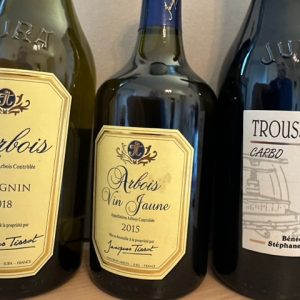Arbois, Jura
The vineyards around Arbois produce some of France’s most unique wines. And Arbois and its neighbouring vineyards are one of France’s most beautiful regions.
So I paid a visit to my good friends Ken and Katarina who live in Arbois, just near the House of Louis Pasteur, who spent much of his life there.
Ken took me on a couple of wonderful wine walks around Arbois. The town is nestled in the surrounding countryside, with vineyards climbing the hills around the town. And these rolling hills blend into other pretty little villages.
I had never previously visited Arbois, despite living over 24 years in France. I don’t know how I missed this beautiful town.
Arbois is most notable for its wines, of which I tasted a few.
The most famous is perhaps “Vin Jaune” (Yellow Wine) which is somewhat similar to dry fino Sherry. It gets its character from being matured in a barrel under a film of yeast, known as the voile, on the wine’s surface.
But unlike Sherry, vin jaune is not a fortified wine. It is made from the Savagnin grape, not to be confused with Sauvignon. A local specialty is coq au vin jaune.
Vin de Paille (Straw wine) is another wine from the region, which resembles Sauternes and is capable of long ageing. It is made from a blend of Chardonnay, Savagnin and the red grape Poulsard. Vins de Paille are also made in other areas of France like Hermitage, Alsace and Corrèze.
Vin de Paille is made from grapes that have been dried off the vine to concentrate their juice. Under the classic method, after a careful hand harvest, selected bunches of ripe grapes will be laid out on mats in full sun. (Originally the mats were made of straw, but these days the plastic nets for the olive harvest are likely to be used).
The technique dates back to pre-Classical times with wines becoming fashionable in Roman times and in late Medieval/Renaissance Europe.
The Arbois region also makes an intriguing red wine from the Trousseau grape variety, also known as Bastardo and Merenzao. Trousseau is a dark-skinned wine grape originally from the Jura, but which has made its way over the centuries to vineyards in northwestern Spain and various parts of Portugal.
Wines made from Trousseau are very powerful, with a deep cherry-red color and flavors redolent of dark red berries and other forest fruits. And without being a sparkling wine, Trousseau wines have a curious sparkling sensation on the tongue. There are a small number of producers of Trousseau in Australia with plantings in Tasmania, Margaret River in Western Australia and Barossa Valley, South Australia.
Excellent dry white wines are also made from the Savagnin grape.
Although it took me almost a quarter century to visit Arbois, I am already planning a return visit. This beautiful town still has many mysteries to unlock, like another indigenous red grape Ploussard/Poulsard, as well as a Crémant du Jura (sparkling wine) made from poulsard, pinot noir, trousseau, chardonnay et savagnin.





